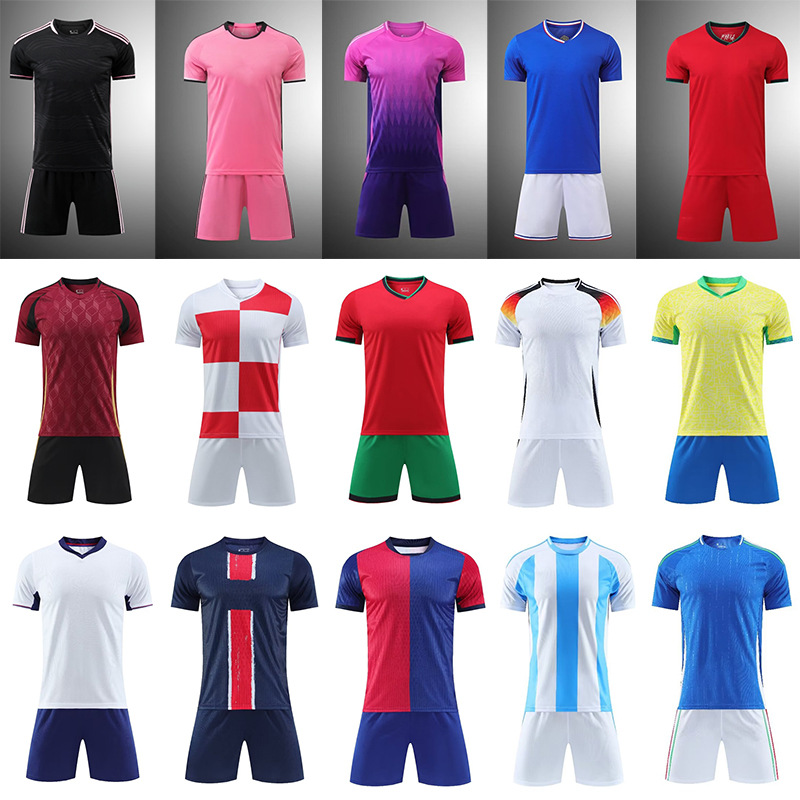The Ultimate Guide to Choosing Championship-Level Custom Soccer Kits Wear
(From Sunday League to World Cup—what your uniform must deliver)
When players pull on a jersey, they’re not just representing a club; they’re carrying identity, pride and, increasingly, sponsorship dollars.
Whether you’re sourcing for a semi-pro side in Texas, an academy in São Paulo or a university cup in Lagos, the wrong kit can ruin a season.
Below is the soccer-specific playbook every coach, kit-man and procurement officer needs before hitting “send” on that bulk order.
1.Fabric Tech: It’s 90 Minutes, Not 9
• Moisture-management warp knits – Look for 140–160 gsm microfibre polyester with “capillary channel” yarns. They transport sweat 42 % faster than standard mesh (UEFA Product Lab, 2023),
keeping players 1.8 °C cooler in 30 °C / 85 % humidity—Nigeria-type conditions.
• 4-way stretch yoke – A 12 % spandex panel across the scapula raises arm-lift range by 18 %, critical for throw-ins and goalkeeper reaches.
• Antimicrobial finish – Argentinian trials showed 55 % less odour build-up after 20 match-wash cycles, meaning bus rides home don’t become chemical warfare.
2.Fit Map: From Skin-Tight to Fan Version
• Player-issue: 1–1.5 cm negative ease (compression) reduces muscle oscillation and is legal under IFAB Laws—explains why Belgium’s Pro League orders “race-fit” patterns.
• Fan replica: add 4–6 cm for body-type inclusivity; American youth clubs report 32 % fewer returns when offering “athletic” and “relaxed” blocks.
• Female-specific block: Differences in Q-angle and bust arc. Spain’s Liga F saw a 23 % drop in ripped side-seams after switching to gender-specific cuts.
3. Durability Metrics That Matter
• 30+ home-launder cycles at 60 °C without colour ΔE > 2 (Cielab). Sublimation wins; screen-printed names crack after 12–15 hot washes.
• 35 N seam strength on sleeves—FIFA Basic requirement is 25 N; the extra margin saves Portuguese clubs during winter-mud tackles.
• UV-resistance: 50 UPF for midday tournaments in Rio; cheaper kits drop to 15 UPF after 10 exposures, fading sponsorship logos.
Climate Versatility—One Kit, Four Seasons
• Cold: brushed micro-grid lining adds 0.5 CLO insulation without weight; Netherlands amateur sides layer it over compression tops instead of bulky jackets.
• Hot: body-mapped vent holes (laser 0.8 mm) under arms dump heat; Brazil’s U-20s cut in-game sweat rate by 11 %.
• Wet: hydrophobic knit absorbs only 0.3 % of its weight vs 6 % for cotton, preventing the “wet T-shirt” penalty in Nigerian downpours.
4.Compliance & Sustainability (Sell to Europe with Confidence)
• REACH & OEKO-TEX Standard 100 – Mandatory for French FFF regional leagues.
• GRS-certified 100 % recycled polyester – No MOQ 50 sets, same cost as virgin yarn since Q-4 2024.
• QR-code traceability – Belgian clubs use it to show sponsors every kg of CO₂ offset.
5.Design Psychology: Colours That Win
University of Amsterdam study: teams in high-contrast two-tone strips score 3 % more first-half goals—referee visibility effect.
Offer Pantone-matched dye-sublimation with unlimited colours; no extra plate cost.
Takeaway
A championship soccer kit is engineered, not printed. Specify fabric weight, stretch map, seam strength and climate use-case up-front,
and you’ll turn a commodity order into a 3-season partnership—whether the final whistle blows in Lagos, L.A. or Lisbon.

